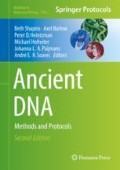Abstract
All organisms release their DNA into the environment through processes such as excretion and the senescence of tissues and limbs. This DNA, often referred to as environmental DNA (eDNA) or sedimentary ancient DNA (sedaDNA), can be recovered from both present-day and ancient soils, fecal samples, bodies of water and lake cores, and even air. While eDNA is a potentially useful record of past and present biodiversity, several challenges complicate data generation and interpretation of results. Most importantly, eDNA samples tend to be highly taxonomically mixed, and the target organism or group of organisms may be present at very low abundance within this mixture. To overcome this challenge, enrichment approaches are often used to target specific taxa of interest. Here, we describe a protocol to amplify metabarcodes or short, variable loci that identify lineages within broad taxonomic groups (e.g., plants, mammals), using the polymerase chain reaction (PCR) with established generic “barcode” primers. We also provide a catalog of animal and plant barcode primers that, because they target relatively short fragments of DNA, are potentially suitable for use with degraded DNA.
Access this chapter
Tax calculation will be finalised at checkout
Purchases are for personal use only
References
Jerde CL, Mahon AR, Chadderton WL, Lodge DM (2011) “Sight-unseen” detection of rare aquatic species using environmental DNA. Conserv Lett 4:150–157. https://doi.org/10.1111/j.1755-263X.2010.00158.x
Taberlet P, Bouvet J (1991) A single plucked feather as a source of DNA for bird genetic studies. Auk 108:959–960
Soininen EM, Valentini A, Coissac E et al (2009) Analysing diet of small herbivores: the efficiency of DNA barcoding coupled with high-throughput pyrosequencing for deciphering the composition of complex plant mixtures. Front Zool 6:16. https://doi.org/10.1186/1742-9994-6-16
Sønstebø JH, Gielly L, Brysting AK et al (2010) Using next-generation sequencing for molecular reconstruction of past Arctic vegetation and climate. Mol Ecol Resour 10:1009–1018. https://doi.org/10.1111/j.1755-0998.2010.02855.x
Wheat RE, Allen JM, Miller SDL et al (2016) Environmental DNA from residual saliva for efficient noninvasive genetic monitoring of Brown Bears (Ursus arctos). PLoS One 11:e0165259. https://doi.org/10.1371/journal.pone.0165259
Nichols RV, Königsson H, Danell K, Spong G (2012) Browsed twig environmental DNA: diagnostic PCR to identify ungulate species. Mol Ecol Resour 12:983–989. https://doi.org/10.1111/j.1755-0998.2012.03172.x
Bohmann K, Evans A, Gilbert MTP et al (2014) Environmental DNA for wildlife biology and biodiversity monitoring. Trends Ecol Evol 29:358–367. https://doi.org/10.1016/j.tree.2014.04.003
Pedersen MW, Ruter A, Schweger C et al (2016) Postglacial viability and colonization in North America’s ice-free corridor. Nature 537:45–49. https://doi.org/10.1038/nature19085
Graham RW, Belmecheri S, Choy K et al (2016) Timing and causes of mid-Holocene mammoth extinction on St. Paul Island, Alaska. Proc Natl Acad Sci U S A 113:9310–9314. https://doi.org/10.1073/pnas.1604903113
Slon V, Hopfe C, Weiß CL et al (2017) Neandertal and Denisovan DNA from Pleistocene sediments. Science 356:605–608. https://doi.org/10.1126/science.aam9695
Coissac E, Hollingsworth PM, Lavergne S, Taberlet P (2016) From barcodes to genomes: extending the concept of DNA barcoding. Mol Ecol 25:1423–1428. https://doi.org/10.1111/mec.13549
Taberlet P, Coissac E, Pompanon F et al (2007) Power and limitations of the chloroplast trnL (UAA) intron for plant DNA barcoding. Nucleic Acids Res 35:e14. https://doi.org/10.1093/nar/gkl938
Epp LS, Boessenkool S, Bellemain EP et al (2012) New environmental metabarcodes for analysing soil DNA: potential for studying past and present ecosystems. Mol Ecol 21:1821–1833. https://doi.org/10.1111/j.1365-294X.2012.05537.x
Bienert F, De Danieli S, Miquel C et al (2012) Tracking earthworm communities from soil DNA. Mol Ecol 21:2017–2030. https://doi.org/10.1111/j.1365-294X.2011.05407.x
Willerslev E, Cappellini E, Boomsma W et al (2007) Ancient biomolecules from deep ice cores reveal a forested southern Greenland. Science 317:111–114. https://doi.org/10.1126/science.1141758
Riaz T, Shehzad W, Viari A et al (2011) ecoPrimers: inference of new DNA barcode markers from whole genome sequence analysis. Nucleic Acids Res 39:e145. https://doi.org/10.1093/nar/gkr732
Valentini A, Taberlet P, Miaud C et al (2016) Next-generation monitoring of aquatic biodiversity using environmental DNA metabarcoding. Mol Ecol 25:929–942. https://doi.org/10.1111/mec.13428
Dalén L, Lagerholm VK, Nylander JAA et al (2017) Identifying bird remains using ancient DNA barcoding. Genes (Basel). https://doi.org/10.3390/genes8060169
Taylor PG (1996) Reproducibility of ancient DNA sequences from extinct Pleistocene fauna. Mol Biol Evol 13(1):283–285
Boessenkool S, Epp LS, Haile J et al (2012) Blocking human contaminant DNA during PCR allows amplification of rare mammal species from sedimentary ancient DNA. Mol Ecol 21:1806–1815. https://doi.org/10.1111/j.1365-294X.2011.05306.x
Giguet-Covex C, Pansu J, Arnaud F et al (2014) Long livestock farming history and human landscape shaping revealed by lake sediment DNA. Nat Commun 5:3211. https://doi.org/10.1038/ncomms4211
Tillmar AO, Dell’Amico B, Welander J, Holmlund G (2013) A universal method for species identification of mammals utilizing next generation sequencing for the analysis of DNA mixtures. PLoS One 8:e83761. https://doi.org/10.1371/journal.pone.0083761
Nichols RV, Vollmers C, Newsom LA et al (2018) Minimizing polymerase biases in metabarcoding. Mol Ecol Res 18:927–939. https://doi.org/10.1111/1755-0998.12895
Seersholm FV, Pedersen MW, Søe MJ et al (2016) DNA evidence of bowhead whale exploitation by Greenlandic Paleo-Inuit 4,000 years ago. Nat Commun 7:13389. https://doi.org/10.1038/ncomms13389
Schnell IB, Bohmann K, Gilbert MTP (2015) Tag jumps illuminated—reducing sequence-to-sample misidentifications in metabarcoding studies. Mol Ecol Resour 15:1289–1303. https://doi.org/10.1111/1755-0998.12402
Rohland N, Reich D (2012) Cost-effective, high-throughput DNA sequencing libraries for multiplexed target capture. Genome Res 22:939–946. https://doi.org/10.1101/gr.128124.111
Acknowledgments
P.D.H. acknowledges support from the Research Council of Norway (Grant 250963: “ECOGEN”).
Author information
Authors and Affiliations
Corresponding author
Editor information
Editors and Affiliations
Rights and permissions
Copyright information
© 2019 Springer Science+Business Media, LLC, part of Springer Nature
About this protocol
Cite this protocol
Nichols, R.V., Curd, E., Heintzman, P.D., Shapiro, B. (2019). Targeted Amplification and Sequencing of Ancient Environmental and Sedimentary DNA. In: Shapiro, B., Barlow, A., Heintzman, P., Hofreiter, M., Paijmans, J., Soares, A. (eds) Ancient DNA. Methods in Molecular Biology, vol 1963. Humana Press, New York, NY. https://doi.org/10.1007/978-1-4939-9176-1_16
Download citation
DOI: https://doi.org/10.1007/978-1-4939-9176-1_16
Published:
Publisher Name: Humana Press, New York, NY
Print ISBN: 978-1-4939-9175-4
Online ISBN: 978-1-4939-9176-1
eBook Packages: Springer Protocols

